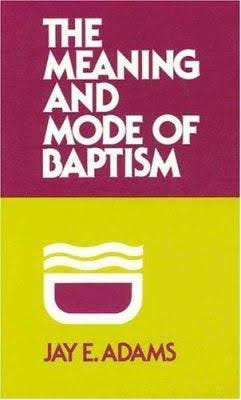Little time is spent discussing the mode of baptism these days. Debates on the recipients of baptism abound, but once that question is solved, how then shall we baptize? With water, of course. In what way then is it administered? Paedobaptists have historically poured or sprinkled. The Westminster Confession states that pouring and sprinkling are the right ways of administering baptism. That the Divines dedicated a section of the Confession to the mode of baptism indicates that it was an important element within Presbyterian/Reformational early history.
As a pastor of a Reformed congregation who has poured water over the heads of 11 people in these last four years I am fully convinced that pouring is the ordained manner for recipients of baptism, whether young (infants) or old. However, to accommodate our baptist friends who have found Providence Church to be a place of joyful and faithful covenant living and who desire to become members of our body, we have made exceptions to such people who are not convinced of the biblical and historical merits of pouring (or sprinkling). These exceptions are rare, but they are provided.

About ten years ago as I considered the baptism issue for the first time I was handed a little book by Jay Adams entitled The Meaning and Mode of Baptism. In those 60 pages, Adams provided a convincing exegetical and historical argument in favor of pouring or sprinkling as proper modes of baptism. Adams argued rather strongly that immersion is not an appropriate mode. In a footnote (pg. 6), he relates his experiences in talking with immersionists. According to Adams, immersionists assume that pouring or sprinkling is merely a tradition’s carry-over, and thus not rooted in the study of Scriptures. Adams expresses his utter shock at their quick dismissal. He then proceeds to offer a biblio-theological case for pouring. He writes:
…In discussing the question biblically, immersionists seems unprepared for this sort of discussion as though they never expected anyone to argue for sprinkling from the Scripture.
This leads Adams to conclude that “immersion is propagated as a biblical mode more by repetition and assertion than from conviction stemming from careful Bible study (5).”
The study itself–as Adams and others demonstrate–includes a lot of assumptions which when challenged prove to not be a threat at all to the argument for pouring. Incidentally, James B. Jordan has also added his contributions on the exclusivity of pouring from a typological perspective. When one connects the typological evidence (as an example, the pouring of the Spirit of God upon the people at Pentecost) and the exegetical evidence (as an example, Isaiah 52:15, which promises a day when God shall sprinkle his people), it is reasonable then to grant pouring or sprinkling as legitimate and biblical modes of baptism.
The post The Mode of Baptism appeared first on Resurrectio et Vita.
